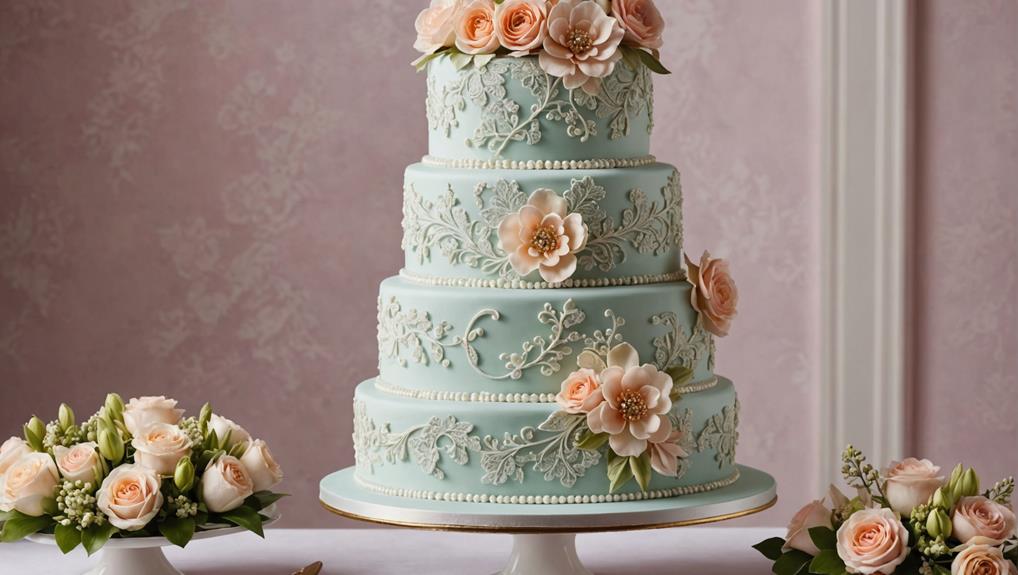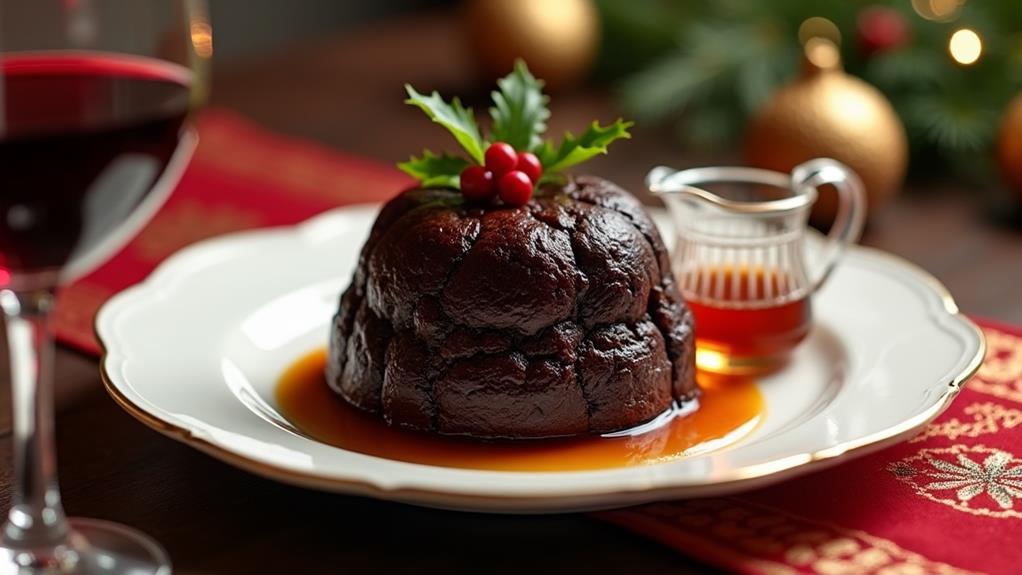To master cake artistry, you'll need essential tools like offset spatulas, turntables, and piping bags. Start by perfecting your buttercream techniques, focusing on smooth applications and intricate piping designs. Explore fondant fundamentals for flawless cake finishes and advanced sculpting. Develop precision and patience through practice, paying attention to detail in sugar flower crafting and coloring techniques. Experiment with creative concepts, drawing inspiration from diverse sources like architecture and fashion. Balance flavor with aesthetics, ensuring your cakes taste as good as they look. As you hone your skills, you'll unlock a world of sweet possibilities in professional cake decoration.
Essential Tools for Cake Artistry
Frequently overlooked by novice bakers, the right tools can make or break your cake artistry endeavors. As you delve into the world of cake decorating, you'll discover that a well-equipped toolkit is essential for creating stunning cake designs.
Start with offset spatulas, which are indispensable for achieving smooth, even frosting applications. Pair these with a sturdy cake turntable to effortlessly maneuver your creation while decorating. Don't forget the bench scraper – it's your secret weapon for creating clean, sharp edges that'll elevate your cake's appearance.
To unleash your creativity in cake design, invest in a variety of piping bags and tips. These allow you to craft intricate patterns, textures, and even delicate sugar flowers.
For fondant work, you'll need specialized tools like rolling pins, smoothers, and cutters to shape and refine your edible canvas. Edible markers and airbrush kits offer innovative ways to add personalized touches and eye-catching color gradients.
Perfecting Buttercream Techniques
The art of perfecting buttercream techniques is a cornerstone of cake decoration. As you delve into this sweet world of cake artistry, you'll discover that mastering buttercream requires understanding its various types.
American, Swiss meringue, and Italian meringue buttercreams each offer unique textures and flavors, allowing you to tailor your approach to different decorating styles.
To achieve a flawless finish, you'll need to hone your smoothing skills using tools like bench scrapers and offset spatulas. Don't shy away from chilling your cake to set the buttercream before final touches.
When it comes to piping intricate designs, let's explore the realm of piping bags and tips. Star, round, and petal tips become your artistic instruments, creating everything from delicate rosettes to intricate lace patterns.
Consistency is key in buttercream work. Too soft, and your designs sag; too stiff, and piping becomes a challenge. Master temperature control and ingredient ratios to maintain the perfect texture.
Fondant Fundamentals and Applications
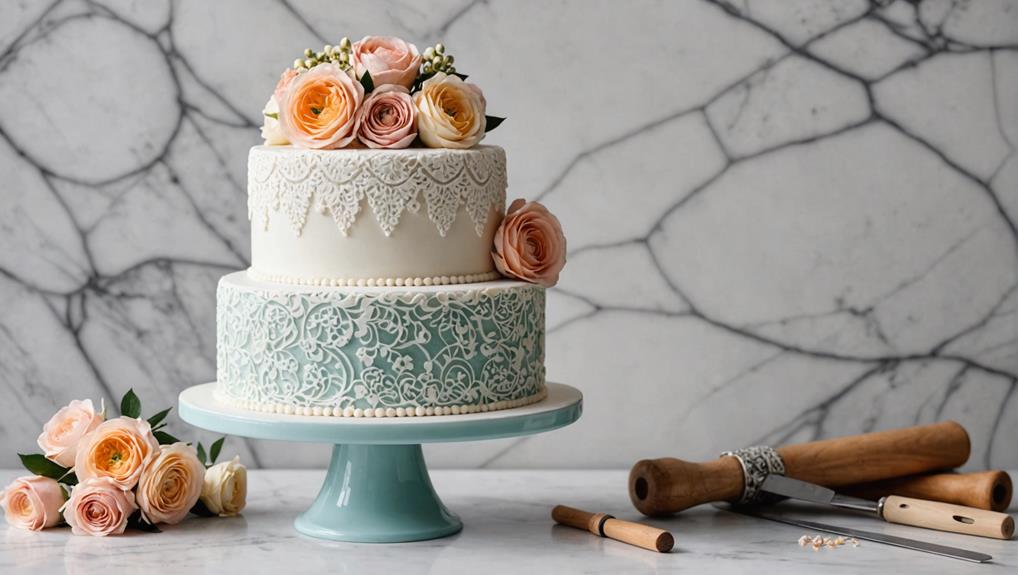
As you venture into fondant fundamentals, you'll need to master the basics of preparing and handling this versatile sugar paste.
You'll learn how to knead, color, and roll out fondant to achieve that flawless, smooth finish on your cakes.
Once you've grasped these essentials, you can explore advanced techniques like draping, ruffling, and sculpting to create stunning 3D decorations that will elevate your cake artistry to new heights.
Fondant Basics and Preparation
Mastering fondant is a crucial skill for any aspiring cake artist. This versatile sugar paste allows you to create smooth, flawless cake coverings and intricate decorations.
To prepare fondant, dust your work surface with cornstarch or powdered sugar to prevent sticking. Knead the fondant until it's smooth and pliable, incorporating any desired flavors or colors during this process. Proper fondant storage methods are essential; wrap it tightly in plastic and store in an airtight container at room temperature to maintain its texture.
When working with fondant, consider these innovative techniques:
- Experiment with fondant texture variations by adding tylose powder for a firmer consistency.
- Try unique fondant flavoring options like lavender or matcha for distinct taste profiles.
- Create marbled effects by gently mixing different colored fondants.
- Use impression mats to add intricate patterns to your fondant surfaces.
Before applying fondant to your cake, ensure you've covered it with a smooth layer of buttercream or ganache. This base helps the fondant adhere properly and creates a flawless finish.
With practice and experimentation, you'll soon be creating stunning fondant masterpieces that showcase your artistic vision and technical skill.
Advanced Fondant Techniques
Fondant's versatility opens up a world of advanced techniques for cake artists to explore. As you delve into fondant sculpting techniques, you'll discover the medium's incredible pliability, allowing you to craft intricate designs and figures.
By manipulating the texture, you can create everything from smooth, polished surfaces to elaborate, lifelike details. Master the art of draping and frilling to add elegance and dimension to your cakes, elevating their visual appeal.
Color blending strategies play a crucial role in advanced fondant work. You'll learn to use colorants and edible dusts to transform your creations, achieving vibrant hues and subtle shades that bring your designs to life.
As you progress, you'll develop skills in crafting complex structures for themed cakes, pushing the boundaries of what's possible with this versatile medium.
Mastering Intricate Piping Designs
In order to create stunning cake designs, mastering intricate piping techniques is essential. You'll need to develop a steady hand and practice various methods like rosettes, shells, and borders. Choosing the right medium is crucial; buttercream offers versatility, while royal icing provides stiffness for detailed work.
Temperature control plays a vital role in achieving precision, so keep your buttercream at the right consistency and use chilled cakes for best results.
To elevate your piping skills, focus on these key areas:
- Piping pressure control: Maintain consistent pressure for uniform designs
- Tip selection strategies: Choose the right tips for specific patterns and textures
- Color blending techniques: Combine hues for visually striking effects
- Practice various patterns: Master rosettes, shells, and borders
Understanding different piping tips is essential for creating distinct patterns. Round tips produce clean lines, star tips create texture, and leaf tips add natural elements.
As you progress, you'll learn to combine colors and styles, unleashing your creativity to craft unique designs. Remember, mastering intricate piping isn't just about technique; it's about pushing boundaries and innovating in the world of cake artistry.
Creating Flawless Cake Finishes

A flawless cake finish is the hallmark of professional cake artistry. To achieve this level of perfection, you'll need to master several key icing techniques.
Start by leveling your cake layers, ensuring a stable foundation for your creation. Chilling the layers before assembly is a game-changer, as it enhances cake stability and prevents unwanted shifting during the decorating process.
Next, apply a crumb coat—a thin layer of frosting that seals in stray crumbs. This crucial step sets the stage for a pristine final layer.
When you're ready to add the finishing touches, use a bench scraper or spatula to smooth the frosting, removing any imperfections. Maintain consistent pressure while piping to achieve an even application of frosting across the cake's surface.
Inspiring Creative Cake Concepts
To discover unconventional design inspiration for your cake creations, look beyond the confines of traditional baking resources.
You'll find a wealth of creative ideas by exploring contemporary art, architecture, fashion, and even nature, which can help you push the boundaries of cake decoration.
Unconventional Design Inspiration
Cake artistry thrives on unconventional design inspiration, pushing the boundaries of traditional confectionery.
You'll find that drawing from diverse sources can elevate your creations to new heights. Nature-inspired motifs, fashion-forward designs, and pop culture themes are just the beginning of what's possible in the world of cake decoration.
To expand your creative horizons, consider these unconventional sources of inspiration:
- Architectural features: Incorporate geometric shapes and structural designs into your cakes, experimenting with fondant and gumpaste to create visually striking pieces.
- Fashion trends: Fuse cake artistry with high-end fashion influences by replicating fabric textures and current color palettes.
- Minimalism or maximalism: Choose between clean lines and subtle colors or extravagant embellishments and intricate details to create visually compelling cakes.
- Pop culture references: Design whimsical characters or scenes that tell a story through your edible creations, drawing from movies, music, and art.
Pushing Decorative Boundaries
Countless cake decorators are pushing the boundaries of their craft, inspiring a new wave of creative concepts that challenge traditional notions of what's possible.
You'll find that modern techniques like edible printing and fondant sculpting allow for intricate designs that were once unimaginable. These innovations enable you to experiment with innovative textures, cultural influences, and experimental shapes, transforming cakes into true works of art.
To stay ahead of the curve, you'll want to draw inspiration from various disciplines. Fashion and architecture can inform your cake designs, helping you create structures that reflect contemporary aesthetics.
Don't be afraid to incorporate unconventional elements, such as bold colors or asymmetrical forms, to make your cakes stand out.
Social media platforms are excellent resources for discovering new trends and sharing your unique creations. You can elevate your designs by mastering techniques like lace patterns and floral motifs, which showcase your artistic expression and skill.
As cake decorating trends evolve, from minimalist chic to extravagant opulence, you'll need to continually innovate and redefine your approach to this sweet art form.
Developing Precision and Patience
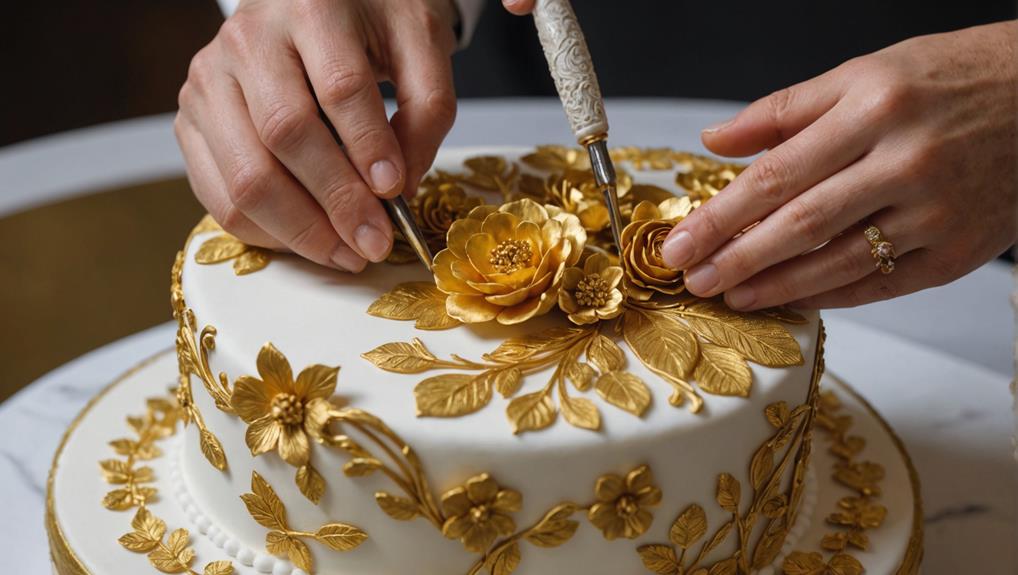
Aspiring cake artists quickly learn that developing precision and patience is essential for creating stunning designs.
Your journey to mastery involves honing measurement accuracy, establishing effective practice routines, and cultivating artistic patience. These skills are crucial for executing intricate techniques like piping and fondant sculpting, which often require multiple attempts to perfect.
To elevate your cake decorating skills, focus on:
- Perfecting foundational techniques (leveling cakes, rolling fondant)
- Practicing steady-handed piping for consistent results
- Mastering the art of smooth frosting application
- Developing patience for time-intensive sugar flower creation
Advanced Sugar Flower Crafting
In advanced sugar flower crafting, you'll master the art of realistic petal construction, learning to shape and texture each delicate piece to mimic nature's intricacies.
You'll explore coloring and dusting techniques that breathe life into your creations, using subtle shades and gradients to capture the essence of real blooms.
Realistic Petal Construction
Crafting realistic sugar flower petals is a hallmark of advanced cake artistry. You'll need to master the art of using gum paste or fondant mixed with tylose powder to create flexible, lifelike petals.
Attention to detail is crucial, as you'll be replicating nature's intricate designs. To achieve this level of realism, focus on:
- Texture enhancement methods
- Flower anatomy study
- Petal aging techniques
- Color matching and application
Start by understanding the natural growth patterns of your chosen flower. Use specialized tools like petal veiners and floral wires to add dimension and authenticity.
When it comes to coloring, employ dusts, airbrush techniques, and edible paints to recreate the subtle gradients found in real blooms. Don't forget the importance of the drying process; allow your petals to dry in a controlled environment to maintain their shape and structure.
Coloring and Dusting Techniques
Delving into the world of advanced sugar flower crafting, you'll find that coloring and dusting techniques are essential for creating lifelike blooms. To achieve petal realism, you'll need to master the use of dusting powders, such as petal dust and luster dust. These fine powders enhance color and shine, bringing your sugar flowers to life.
Airbrushing is a game-changer for achieving gradient effects and intricate color variations. This technique adds depth and dimension to your creations, elevating them from simple sugar structures to works of art.
For even more precision, try mixing dusting powders with rejuvenator or clear alcohol. This creates a paint-like consistency, allowing you to add fine details and artistic accents to your flowers.
To truly capture nature's beauty, focus on incorporating colored veining and petal edges through careful dusting. These subtle touches will make your sugar flowers appear more lifelike and visually appealing.
Remember to store your dusting powders properly in airtight containers to maintain their potency and prevent clumping. With these advanced techniques at your fingertips, you'll be crafting stunning, realistic sugar flowers in no time.
Assembling Complex Arrangements
With your sugar flowers beautifully colored and dusted, it's time to bring them together into stunning arrangements. Assembling complex sugar flower compositions requires a combination of artistry and technical skill.
You'll need to master flower arrangement techniques that balance color, shape, and size while incorporating wire support methods to ensure structural integrity. Texture enhancement strategies, such as adding sugar leaves and fillers, will elevate your creations to new heights of realism and sophistication.
To create truly impressive sugar flower arrangements:
- Use floral wire and tape to construct a sturdy base for your composition.
- Arrange larger blooms first, then fill in with smaller flowers and buds.
- Incorporate various textures by adding sugar leaves, berries, and filler flowers.
- Adjust flower positions and angles to create depth and visual interest.
Color Theory in Cake Design
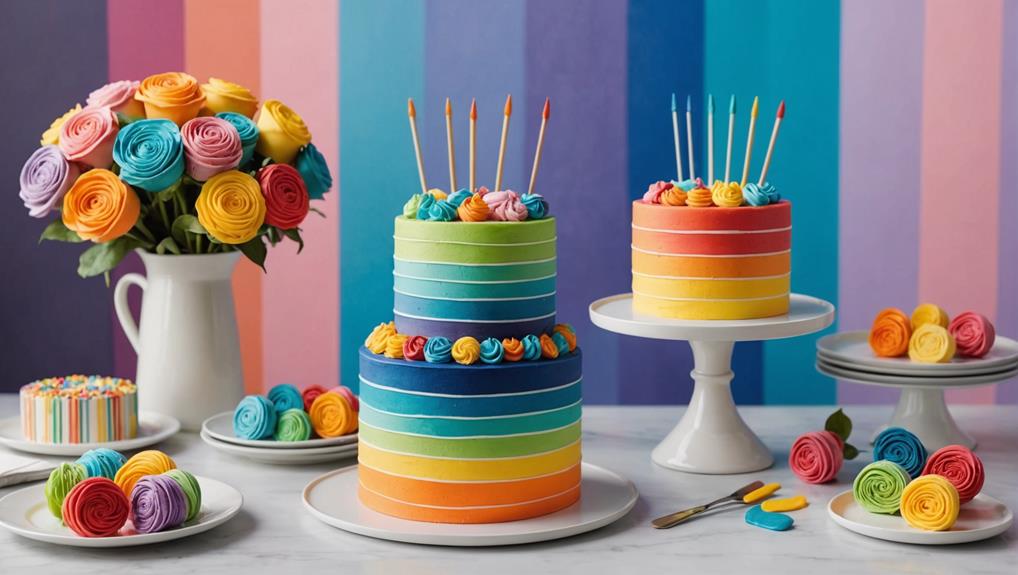
Color theory stands out as a foundational element in cake design, influencing everything from a cake's visual appeal to its perceived taste. As you delve into this crucial aspect of cake artistry, you'll discover how the color psychology impact can transform your creations.
Start by mastering the color wheel, which serves as your roadmap to color palette harmony. You'll learn that warm hues like red and yellow evoke excitement, while cool tones like blue and green create a sense of calm.
To elevate your designs, experiment with striking contrast techniques using complementary colors. These opposites on the color wheel will make specific elements pop, drawing the eye to key features of your cake.
For a more subtle approach, try using analogous colors to achieve an elegant, cohesive look. Remember, your color choices can even influence taste perception; vibrant hues often make cakes seem more flavorful and inviting.
Balancing Flavor and Aesthetics
While color theory brings visual appeal to your cakes, it's the interplay between flavor and aesthetics that truly defines cake artistry.
As a professional decorator, you must master the delicate balance between stunning visuals and mouthwatering taste. This equilibrium is crucial for meeting client expectations and elevating your craft.
To achieve this harmony, consider these key strategies:
- Prioritize high-quality ingredients for enhanced flavor and visual appeal.
- Utilize flavor infusion techniques in frostings and cake layers.
- Develop a deep understanding of flavor profiles for harmonious taste pairings.
- Seek client feedback to refine your balance of artistry and taste.
Frequently Asked Questions
Who Owns the Cake Decorating Company?
You'll find cake decorating companies are owned by various individuals. From famous cake designers setting trends to family-run businesses passing down traditions, ownership varies. Innovative entrepreneurs are also launching their own cake businesses, revolutionizing the industry with fresh ideas.
Who Is the Best Hyper Realistic Cake Artist in the World?
Imagine a cake that's indistinguishable from a ripe peach. You'll find it hard to crown a single "best" hyper-realistic cake artist. Famous cake artists like Tatyana Sokolova and Michelle J. Cake inspire with their innovative techniques, pushing cake art's boundaries.
Is Cake Decorating an Artist or Artisan?
You'll find cake decorating blends artistry and artisanship. It's a creative expression that demands skill development and technique evolution. You're not just crafting; you're innovating, pushing boundaries between edible art and culinary craftsmanship with each unique creation.
Who Makes the Professional Cakes on Is It Cake?
Like sculptors of sugary illusions, you'll find a diverse team of skilled bakers crafting the professional cakes on "Is It Cake?". They're masters of cake design techniques, flavor pairing strategies, and creative frosting methods, pushing the boundaries of edible artistry.
Final Thoughts
You've embarked on a sweet journey through the art of cake decoration, much like a painter mastering their canvas. Just as Leonardo da Vinci spent years perfecting his craft, you'll find that cake artistry requires patience and practice. Remember, even the most intricate sugar flowers start as simple shapes. As you continue to refine your skills, you'll transform humble ingredients into edible masterpieces that delight both the eye and the palate. Your creative potential is as limitless as the flavors you can imagine.

